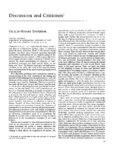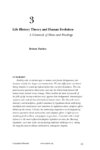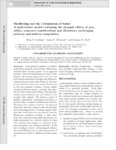|
|
Creator | Title | Description | Subject | Date |
| 1 |
 |
Hawkes, Kristen | On life history evolution (a comment on Chisholm) | Chisholm (CA 34:I-24) is right that the theory, models, and data of evolutionary biology apply to questions asked by social scientists. Work in life-history theory (Stearns 1992, Roff 1992, Charnov 1993) has especially provocative implications for the understanding of human development (see review i... | | 1994-01-01 |
| 2 |
 |
Hawkes, Kristen | The derived features of human life history | This chapter compares and contrasts the life histories of extant great apes in order to construct a hypothetical life history of the last common ancestor of all great apes and to identify features of human life history that have been derived during the evolution of our lineage. Data compiled from th... | | 2006-01-01 |
| 3 |
 |
O'Rourke, Dennis H. | Unangan past and present: the contrasts between observed and inferred histories | Abstract Academic research focusing on the population and culture history of the Aleut (Unangan) people began in the late 19th century and continues to the present. The papers in this special issue of Human Biology summarize the latest results from archaeological, linguistic, genetic, and morphometr... | | 2010 |
| 4 |
 |
Hawkes, Kristen | Life history theory and human evolution : a chronicle of ideas and findings | Fertility ends at similar ages in women and female chimpanzees, but humans usually live longer and mature later. We also differ from our closest living relatives in weaning infants before they can feed themselves. The comparisons pose questions about when and why the distinctively human life history... | | 2006-01-01 |
| 5 |
 |
Hawkes, Kristen | Some current ideas about the evolution of the human life history | Human life history is characterised by a long juvenile period (weaning to reproductive maturity), and a long post-reproductive lifespan in females. How do we explain the differences between our nearest relatives, the great apes, and ourselves? This chapter summarises some recent attempts to use l... | Human life history; Fertility; Apes; Juvenile period | 1999 |
| 6 |
 |
Hawkes, Kristen | Grandmothers and their consequences | Both what we share and don't share with our primate cousins make us human. Easy enough to start a list. At least since Darwin, most would rate moral sentiments as distinctively human. But our modern selves didn't emerge from ancestral apes in one step. When did populations along the way become human... | | 2012-01-01 |
| 7 |
 |
Hawkes, Kristen | Human life histories: primate trade-offs, grandmothering socioecology, and the fossil record | Human life histories differ from those of other animals in several striking ways. Recently Smith and Tompkins (1995, p. 258) highlighted the combination of "slow" and "fast" features of human lives. Our period of juvenile dependency is unusually long, our age at first reproduction is late, and we h... | Meat; Maturity; Life Span | 2003 |
| 8 |
 |
Rogers, Alan R. | Pleistocene population X-plosion? | In two recent papers, Kaessmann et al. presented DNA sequence data from the X chromosome (Xq13.3) of 30 chimpanzees and 69 humans (Kaessmann et al. 1999a; Kaessmann et al. 1999b). These data bear on two longstanding questions involving late Pleistocene demographic history: (1) whether the long-term... | | 2000 |
| 9 |
 |
O'Rourke, Dennis H. | South from Alaska: a pilot aDNA study of genetic history on the Alaska Peninsula and the Eastern Aleutians | Abstract The Aleutian Islands were colonized, perhaps several times, from the Alaskan mainland. Earlier work documented transitions in the relative frequencies of mtDNA haplogroups over time, but little is known about potential source populations for prehistoric Aleut migrants. As part of a pilot i... | | 2010 |
| 10 |
 |
Harpending, Henry C. | Paternal age and genetic load | The incidence of base substitutions in humans increases with the age of the father, which shows up as an increased incidence of mutational disorders in the children of older fathers. There is a less obvious implication: an extended period of high average paternal age in a population will lead to inc... | | 2013-01-01 |
| 11 |
 |
Codding, Brian | Shellfishing and the colonization of sahul: a multivariate model evaluating the dynamic effects of prey utility, transport considerations and life-history on foraging patterns and midden composition | Archaeological evidence of shellfish exploitation along the coast of Sahul (Pleistocene Australia-New Guinea) points to an apparent paradox. While the continental record as a whole suggests that human populations were very low from initial colonization through early Holocene, coastal and peri-c... | | 2014-01-01 |
| 12 |
 |
O'Rourke, Dennis H. | Introduction: origins and settlement of the indigenous populations of the Aleutian Archipelago | The series of papers in this special issue of Human Biology use an interdisciplinary approach to address regional questions and to integrate disparate Aleutian data into a broad, synthetic effort. The contributors leverage decades of data on Aleut origins, biogeography, and behavior through integrat... | | 2010 |
| 13 |
 |
Wiessner, Pauline W. | Vines of complexity - egalitarian structures and the institutionalization of inequality among the Enga | The initial stages of the institutionalization of hierarchical social inequalities remain poorly understood. Recent models have added important perspectives to "adaptationist" approaches by centering on the agency of "aggrandizers" who alter egalitarian institutions to suit their own ends through de... | Egalitarian structures; Political evolution; Social d | 2002-04 |
| 14 |
 |
Rogers, Alan R.; Harpending, Henry C. | Genetic structure of ancient human populations | Discusses mitochondrial DNA (mtDNA) sequences as important source of data about the history of human species. | Tree of descent; Mismatch distributions; Simulations; Findings; Intermatch distributions; Younger and older populations | 2001-09-15 |
| 15 |
 |
Rogers, Alan R.; Jorde, Lynn B. | Genetic evidence on modern human origins | A review of genetic evidence leads to the following conclusions concerning human population history: (1) Between 33,000 and 150,000 years ago the human population expanded from an initial size of perhaps 10,000 breeding individuals, reaching a size of at least 300,000. (2) Although the initial popu... | Population history; Mitochondrial DNA; Mismatch distribution; Intermatch distribution; Replacement hypothesis; Population bottlenecks | 1995 |
| 16 |
 |
Harpending, Henry C.; Jorde, Lynn B. | Culture creates genetic structure in the Caucasus: autosomal, mitochondrial, and Y-chromosomal variation in Daghestan | Near the junction of three major continents, the Caucasus region has been an important thoroughfare for human migration. While the Caucasus Mountains have diverted human traffic to the few lowland regions that provide a gateway from north to south between the Caspian and Black Seas, highland populat... | Caucasus; Haplogroups; Autosomal variation; Mitochondrial variation; Y-chromosomal variation; Endogamy; Avar; Dargin; Kubachi; Culture | 2008 |
| 17 |
 |
McCullough, John M. | Relatedness and kin-structured migration in a founding population: Plymouth colony, 1620-1633 | To test the common assumption of no genetic relationship in a founding population, we calculated average relatedness (r) for the emigrants to Plymouth Colony from Europe on seven voyages from 1620 to 1633. Of 355 individuals, 255 could be individually identified and 4 generations of genealogic depth... | | 1991 |
| 18 |
 |
Broughton, John | Homestead cave Ichthyofauna | Biological evidence on the climatic and hydrographic history of the intermountain region would be much richer, if we had more than the present dribble of paleontological data on the fishes (Hubbs and Miller, 1948, p. 25). In this passage from their landmark synthesis of historical fish biogeograph... | Homestead Cave; Ichthyofauna; Lake Bonneville | 2000 |
| 19 |
 |
Rogers, Alan R. | Genetic evidence for a Pleistocene population explosion | Expansions of population size leave characteristic signatures in mitochondrial "mismatch distributions." Consequently, these distributions can inform us about the history of changes in population size. Here, I study a simple model of population history that assumes that, t generations before the pr... | | 1995 |
| 20 |
 |
Rogers, Alan R.; Jorde, Lynn B. | Modeling the amplification dynamics of human Alu retrotransposons | Retrotransposons have had a considerable impact on the overall architecture of the human genome. Currently, there are three lineages of retrotransposons (Alu, L1, and SVA) that are believed to be actively replicating in humans. While estimates of their copy number, sequence diversity, and levels of ... | Retrotransposons; Amplification dynamics; Mutation; Human-chimpanzee divergence | 2005 |
| 21 |
 |
Wiessner, Pauline W. | On emergency decisions, egalitarianism, and group selection | Boehm (CA 37:763-93) puts forward an important thesis-that with the evolution of egalitarian societies, privileged routes to reproductive advantage are blocked and the power of individua selection severely compromised. With competition so constrained, altruistic behavior can more readily spread i... | Boehm's mode; Evolution of altruistic behavior | 1998-06 |
| 22 |
 |
Cashdan, Elizabeth A. | Why is testosterone associated with divorce in men? | There is evidence that in women high levels of testosterone are associated with more sexual partners and more permissive sexual attitudes. If a similar relationship holds true for men, the higher basal testosterone levels of divorced and unmarried men may be caused by this relationship rather than b... | Marriage; Separation; Hormones; Sexuality | 1998-06 |
| 23 |
 |
Cashdan, Elizabeth A. | Competition between foragers and food producers on the Botletli River, Botswana | The immigration of food-producing groups into areas occupied by hunters and gatherers must have been a common occurrence in prehistory. How were the hunter-gatherers affected by this? I describe here two groups of Kalahari Basarwa ('Bushmen'), one living along the flood plain of the lower Botletli ... | Kalahari Basarwa; Bushmen; Foraging; Cattle | 1986 |
| 24 |
 |
Hawkes, Kristen | Hadza women's time allocation, offspring provisioning, and the evolution of long postmenopausal life spans | Extended provisioning of offspring and long postmenopausal life spans are characteristic of all modern humans but no other primates. These traits may have evolved in tandem. Analysis of relationships between women's time allocation and children's nutritional welfare among the Hadza of northern Tanza... | Child care; Children, nutrition; Life spans, Biology; Mother & child; Primates; Social structure; Women; Time Management; Hominids | 1997 |
| 25 |
 |
Wiessner, Pauline W. | On network analysis: the potential for understanding (and misunderstanding) !Kung Hxaro | Schweizer's social network analysis (CA 38: 739-52) of gift giving among the !Kung San (Ju/'hoansi) demonstrates most elegantly how individual strategies, guided by basic cultural rules, coalesce to form a regional system. Complex connections in the network that defied description with simpler anayt... | Density of kinship; Nonsymmetry; Ethnohistorica | 1998-08 |

























